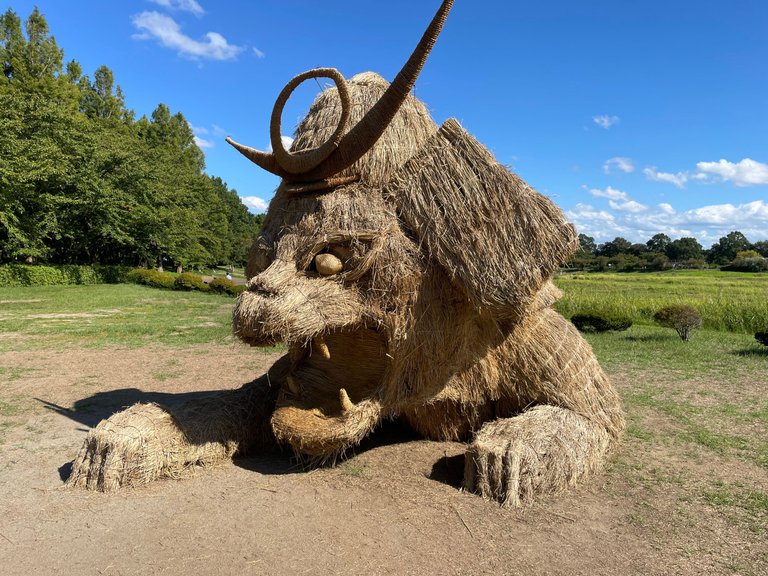When rice straw turns into giants =/= Wenn Reisstroh zu Giganten wird 👹🍣🎎 Wonderful Japan ENG-GER
No life without rice— there is no getting around this expression here in the Far East. And this becomes apparent not only now in autumn, when the rice fields are harvested and the new rice is finally steaming on the tables. Here in Japan, rice is what bread is in Europe: a staple food, a symbol, and a cultural asset.
No wonder there is a separate word for each stage of rice processing: ine for the rice plant, kome for husked rice, and gohan for cooked rice.
But rice is not just for eating, as demonstrated every year by a small but delightful festival that takes place in our area: the Wara Art Festival.
Between the end of August and October, in a local park you can find various monumental sculptures. These sculptures are made from nothing but rice straw (ware) that is left over after the harvest.
What began as a local initiative has developed into a nationally renowned event. Since 2008, students from Musashino Art University have been working together with local volunteers to create impressive works of art from tons of wara. These range from dinosaurs and gorillas to fantasy figures such as dragons and mythological creatures – some up to five meters high.
The idea behind the festival is as creative as it is eco-friendly: instead of throwing away the rice straw, it's used as a building material for artworks. The artists first build a wooden skeleton, which is then covered layer by layer with wara. They use traditional techniques like roofing and basket weaving.
This year's theme is “Echigo's Mythical Creatures,” with five new sculptures inspired by local legends and nature spirits on display.
The first photo today shows a tiger wearing a samurai costume. This is probably a reference to the famous warlord Uesugi Keshin, who once lived in this region.
The second photo shows a mighty koi carp. Over time, these fish have become a world-famous symbol of the Land of the Rising Sun.
DEUTSCH
Ohne Reis kein Leben - an dieser Redewendung kommt man im Fernen Osten nicht vorbei. Und das zeigt sich nicht nur jetzt im Herbst, wenn die Reisfelder abgeerntet werden und endlich der neue Reis dampfend auf den Tischen steht. Denn gerade hier in Japan ist Reis das, was Brot in Europa ist: Lebensmittel, Symbol und Kulturgut.
Kein Wunder, dass es für jede Stufe der Reisverarbeitung ein eigenes Wort gibt: ine für die Reispflanze), kome für den geschälten Reis und gohan für gekochter Reis.
Aber dass Reis nicht nur zum Essen da ist, zeigt jedes Jahr ein kleines aber feines Festival, dass in unseren Gegend stattfindet: das Wara Art Festival.
Zwischen Ende August und Oktober begrüßen in einem lokalen Park verschiedene monumentale Skulpturen die Besucher. Diese Skulpturen sind aus nichts anderem als Reisstroh (Ware) gefertigt, das nach der Ernte übrig bleibt.
Was als lokale Initiative begann, hat sich zu einem landesweit bekannten Event entwickelt. Seit 2008 arbeiten Studierende der Musashino Art University gemeinsam mit lokalen Freiwilligen daran, aus Tonnen von Wara beeindruckende Kunstwerke zu erschaffen. Diese reichen von Dinosauriern über Gorillas bis hin zu Fantasiefiguren wie Drachen oder mythologischen Wesen – einige bis zu fünf Meter hoch.
Die Idee hinter dem Festival ist ebenso kreativ wie umweltbewusst: Statt das Reisstroh zu entsorgen, wird es als Baumaterial für Kunstwerke genutzt. Die Künstler bauen zunächst ein Holzskelett, das dann Schicht für Schicht mit Wara bedeckt wird. Dabei kommen traditionelle Techniken wie Dachdecken und Korbflechten zum Einsatz.
Das diesjährige Thema lautet „Echigos Fabelwesen“, wobei fünf neue Skulpturen, inspiriert von lokalen Legenden und Naturgeistern, präsentiert werden.
Das erste Foro heute zeigt einen Tiger, der ein Samuraikostüm trägt. Dies ist wahrscheinlich eine Reminiszenz an den berühmten Kriegsfürsten Uesugi Keshin, der früher in dieser Region gelebt hat.
Das zweite Foto zeigt einen mächtigen Koi-Karfen. Diese Fische sind im Laufe der Zeit zu einem weltweit bekannten Symbol für das Land der aufgehenden Sonne geworden.
Next, we see Kyuubi, a legendary fox spirit from Japanese folklore. After 1,000 years, a fox is said to develop nine tails and possess immense magical powers. It is often associated with illusions and fire and in the Shintō religion is considered the messenger of the rice goddess Inari.
Als nächstes sehen wir Kyuubi, einen legendärer Fuchsgeist aus der japanischen Folklore. Nach 1.000 Jahren soll ein Fuchs neun Schwänze entwickeln und immense magische Kräfte besitzen. Er ist oft mit Illusionen und Feuer verbunden und gilt in der Shintō-Religion als Bote der Reisgöttin Inari.
Here we have Suiryū, the green dragon. He is worshipped in Japanese temples and acts as a guardian spirit. In Kyoto, for example, he is closely associated with Kiyomizu-dera Temple, where he plays an important role in festivals and rituals.
Hier haben nun Suiryū, der Grüne Drache. Er wird in japanischen Tempeln verehrt und tritt als Schutzgeist auf. In Kyoto ist er zum Beispiel eng mit dem Kiyomizu‑dera Tempel verbunden, wo er in Festen und Ritualen eine große Rolle spielt.
And finally we have Kame, the turtle. She is a symbol of longevity and good fortune, and of a special connection to nature. Kame symbolizes the desired blessing of a good rice harvest.
Well, to be honest, this time I wasn't entirely sure what I was dealing with when I encountered these five characters. I'll probably have to do a little more research, and maybe I'll be able to tell you a little more about them in another post. So please make sure to check back here soon...
Und dann haben wir noch Kame, die Schildkröte. Sie ist ein Symbol für Langlebigkeit und Glück und für eine besondere Verbindung zur Natur. Kame steht hier wohl für den erwünschten Segen für eine gute Reisernte.
Nun ja, um ehrlich zu sein, war ich mir diesmal nicht ganz sicher, womit ich es bei diesen fünf Figuren zu tun hatte. Ich werde wohl noch ein wenig Nachforschungen anstellen müssen und vielleicht kann ich an anderen Stelle euch noch ein wenig mehr dazu erzählen. Also schaut bald wieder hier vorbeii...






so cool how you described the wooden skeleton first, then layering wara with roofing and basket weaving. That blend of craft and reuse feels like closing the loop after harvest, very calm and purposeful. The Kyuubi bit with nine tails after a thousand years made me smile, patience really grows power :) As someone who cares about little efficiencies, this festival reads like a perfect ledger where nothing is wasted and and stories become assets for the season.